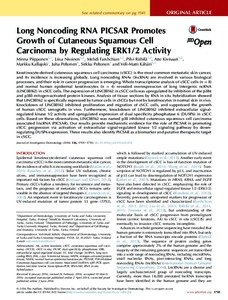Long Noncoding RNA PICSAR Promotes Growth of Cutaneous Squamous Cell Carcinoma by Regulating ERK1/2 Activity
Minna Piipponen; Liisa Nissinen; Mehdi Farshchian; Pilvi Riihilä; Atte Kivisaari; Markku Kallajoki; Juha Peltonen; Sirkku Peltonen; Veli-Matti Kähäri
Long Noncoding RNA PICSAR Promotes Growth of Cutaneous Squamous Cell Carcinoma by Regulating ERK1/2 Activity
Minna Piipponen
Liisa Nissinen
Mehdi Farshchian
Pilvi Riihilä
Atte Kivisaari
Markku Kallajoki
Juha Peltonen
Sirkku Peltonen
Veli-Matti Kähäri
Elsevier
Julkaisun pysyvä osoite on:
https://urn.fi/URN:NBN:fi-fe2021042715624
https://urn.fi/URN:NBN:fi-fe2021042715624
Tiivistelmä
Keratinocyte-derived cutaneous squamous cell carcinoma (cSCC) is the
most common metastatic skin cancer, and its incidence is increasing
globally. Long noncoding RNAs (lncRNA) are involved in various
biological processes, and their role in cancer progression is emerging.
Whole transcriptome analysis of cSCC cells (n = 8) and normal human
epidermal keratinocytes (n = 4) revealed overexpression of long
intergenic ncRNA (LINC00162) in cSCC cells. The expression of LINC00162
in cSCC cells was upregulated by inhibition of the p38α and p38δ
mitogen-activated protein kinases. Analysis of tissue sections by RNA in
situ hybridization showed that LINC00162 is specifically expressed by
tumor cells in cSCCs but not by keratinocytes in normal skin in vivo.
Knockdown of LINC00162 inhibited proliferation and migration of cSCC
cells, and suppressed the growth of human cSCC xenografts in vivo.
Furthermore, knockdown of LINC00162 inhibited extracellular
signal-regulated kinase 1/2 activity and upregulated expression of dual
specificity phosphatase 6 (DUSP6) in cSCC cells. Based on these
observations, LINC00162 was named p38 inhibited cutaneous squamous cell
carcinoma associated lincRNA (PICSAR). Our results provide mechanistic
evidence for the role of PICSAR in promoting cSCC progression via
activation of extracellular signal-regulated kinase 1/2 signaling
pathway by downregulating DUSP6 expression. These results also identify
PICSAR as a biomarker and putative therapeutic target in cSCC.
most common metastatic skin cancer, and its incidence is increasing
globally. Long noncoding RNAs (lncRNA) are involved in various
biological processes, and their role in cancer progression is emerging.
Whole transcriptome analysis of cSCC cells (n = 8) and normal human
epidermal keratinocytes (n = 4) revealed overexpression of long
intergenic ncRNA (LINC00162) in cSCC cells. The expression of LINC00162
in cSCC cells was upregulated by inhibition of the p38α and p38δ
mitogen-activated protein kinases. Analysis of tissue sections by RNA in
situ hybridization showed that LINC00162 is specifically expressed by
tumor cells in cSCCs but not by keratinocytes in normal skin in vivo.
Knockdown of LINC00162 inhibited proliferation and migration of cSCC
cells, and suppressed the growth of human cSCC xenografts in vivo.
Furthermore, knockdown of LINC00162 inhibited extracellular
signal-regulated kinase 1/2 activity and upregulated expression of dual
specificity phosphatase 6 (DUSP6) in cSCC cells. Based on these
observations, LINC00162 was named p38 inhibited cutaneous squamous cell
carcinoma associated lincRNA (PICSAR). Our results provide mechanistic
evidence for the role of PICSAR in promoting cSCC progression via
activation of extracellular signal-regulated kinase 1/2 signaling
pathway by downregulating DUSP6 expression. These results also identify
PICSAR as a biomarker and putative therapeutic target in cSCC.
Kokoelmat
- Rinnakkaistallenteet [27094]
